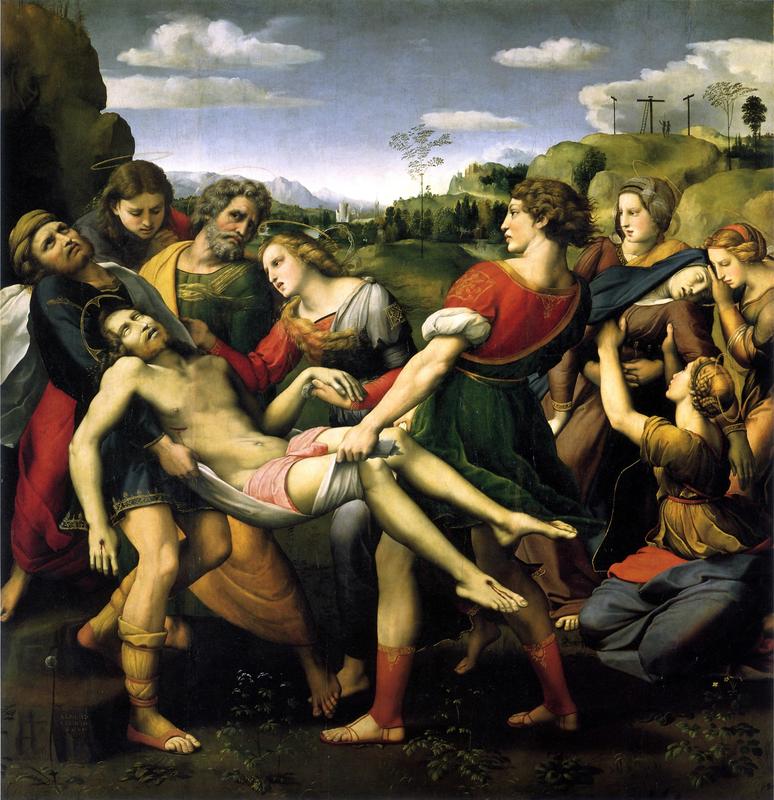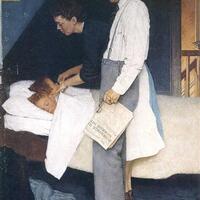More about The Deposition

Sr. Contributor
Though the story of Jesus’s entombment is well known, the inspiration behind Raphael's painting is a different bloody tale.
Atalanta Baglioni commissioned this altarpiece from Raphael as a memorial for her son Grifonetto who had recently passed. His likeness is captured in the young man on the right helping to carry Jesus. To put it bluntly, Grifonetto was far from a saint, he took part in a real-life Red Wedding. Grifonetto and a few others conspired to kill the rest of the men in their family at a wedding. They killed almost all of them, including the groom in the arms of his new bride. One relative named Gianpaolo Baglioni managed to escape by running across rooftops.
His mother was understandably miffed with him murdering his own family, so she refused to let Grifonetto come home and cursed him. Soon after, she had a change of heart but was too late. Gianpaolo found Grifonetto in the streets and killed him. If this story sounds vaguely familiar to you, it may be cause Grifonetto’s death was briefly mentioned in The Picture of Dorian Grey.
Many studies and sketches of The Deposition survive as Raphael took his time and played around with the composition of figures and sought inspiration from works by artists such as Michelangelo. It was his second commission for the church of San Francesco al Prato in Perugia. The first was for Coronation of the Virgin, commissioned by Atalanta Baglioni’s sister-in-law from a rival family.
After completion, this painting had a few adventures of its own. It was removed by a gang working for the nephew of Pope Paul V in 1608. Later in 1797 Napoleon confiscated it and it was briefly displayed at the Louvre, then called the Napoleon Museum. It was returned in 1815, but recently in the summer of 2014 it was damaged in the summer heat. The Borghese Gallery had some trouble with the AC unit and the wood paneling of the painting was warped. It has since been restored.
Sources
- Brinton, Selwyn. The Renaissance in Italian Art; a Series in Nine Parts. Vol. 8. London: A. Fairbairns, 1907.
- “Deposition or the Entombment by Raphael.” Borghese Gallery, August 4, 2019. https://borghese .gallery/collection/paintings/deposition-by-raphael.html.
- Jones, Roger, and Nicholas Penny. Raphael. Yale University Press, 1983.
- Milliard, Coline. “Priceless Raphael Falls Victim to Faulty AC.” artnet News. artnet News, April 23, 2015. https://news.artnet.com/exhibitions/priceless-raphael-falls-victim-to-f… -90304.
- Sanzio, Raffaello, and Marcia B. Hall. The Cambridge Companion to Raphael. Cambridge: Cambridge Univ. Press, 2008.
- “Studies for a Deposition: the Borghese Entombment.” Royal Collection Trust. Accessed April 20, 2020. https://albert.rct.uk/collections/raphael-collection/new-testament-subj… /studies-for-a-deposition-the.
Featured Content
Here is what Wikipedia says about The Deposition (Raphael)
The Deposition, also known as the Pala Baglioni, Borghese Entombment or The Entombment, is an oil painting by the Italian High Renaissance painter Raphael. Signed and dated "Raphael. Urbinas. MDVII", the painting is in the Galleria Borghese in Rome. It is the central panel of a larger altarpiece commissioned by Atalanta Baglioni of Perugia in honor of her slain son, Grifonetto Baglioni. Like many works, it shares elements of the common subjects of the Deposition of Christ, the Lamentation of Christ, and the Entombment of Christ. The painting is on wood panel and measures 184 x 176 cm.
Check out the full Wikipedia article about The Deposition (Raphael)














The first thing I notice in this painting (Deposition of Christ) by Raphael Is a vertical line which subdivides a square into two quadrants that have different actions happening in the same frame. In the left quadrant I see a group of people struggling to keep Christ from falling down. On the right quadrant, I can see Mary has fainted and is falling down being supported by various figures. The organization of this painting is magnificent, right in the middle of the painting I can see how Raphael has put all the heads in that part of the painting to better portray the expressions of the figures. Another thing to keep an eye on is the dynamic force opposing both sides of the painting. A great example of this is the head of the figure holding the upper body of Jesus in the left side of the quadrant is pushed back and on the right quadrant, we can see the same happening with the head of Mary. This all shows the great mastery of space, organization, and direction that Raphael had.